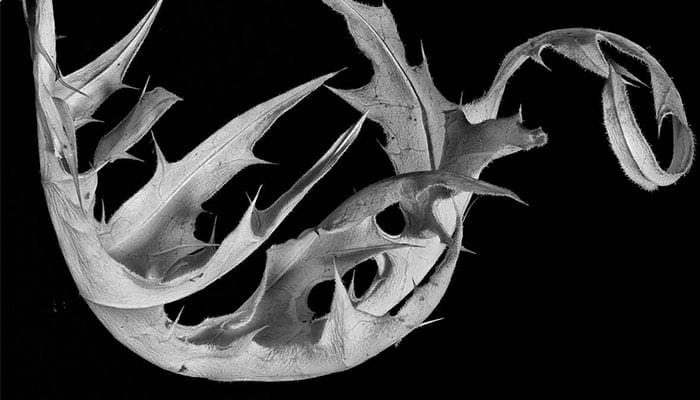News
Art@BTI: Artist Interview with Susan C. Larkin

Image: Acanthus mollis by Susan C. Larkin
Here at BTI we like to grace our walls with temporary exhibits by regional artists. Talented artists are invited to showcase their works for the enjoyment and enrichment of the BTI community and their visitors. Art, like science, is an endeavor that encourages discovery and inspires creativity. We think this is a perfect reason to host exhibits at the institute! Please join us on September 29, 2016 at 5:00 pm for an art and science program celebrating this exhibit.
The program is curated and coordinated by Development and Communications staff. Please be in touch with Kitty Gifford if you have any questions or suggestions.
Tell me about your work?
My main interest is in macro photography. I like to take close-ups, mostly of plants in the final stages of the growing cycle. The prints are in black and white. I search for texture, shape, and translucence and how they can be enhanced by light.
What are you currently working on?
For the last eight years my main project has been making images of plants in the final stages of the growing cycle. When I can, I include insects. Sometimes in spring, I leave the plant remnants and make images of flowers in color.
I’m also a photography student at Tompkins Cortland Community College. This year I have been working on a history project which will be on display at the History Center in Ithaca this coming spring. It will be part of the recognition of the 200th anniversary of Tompkins County.
How is this different from past projects?
Before I started working on close-ups of plants I made a book of stories about our neighborhood in the town of Caroline. The photographs were of people in the 70s and the same people now. Along with the pictures were the stories of our neighborhood in Caroline in the 1970s.
How did you decide to become an artist?
My mother was an artist and my father was a member of the Kodak Camera Club. I resisted art for thirty years and taught elementary school instead. However, when I retired and found photography classes at TC3, my resistance turned to fascination. I have been a photography student at TC3 since 2005.
What was the best advice given to you as an artist?
Work on what you love, but keep your mind open to new possibilities. This came from my years at TC3. More specific advice on what to keep in mind comes from the chapter titles in Stephen Shore’s book, The Nature of Photographs: Frame, Flatness, Focus, and Time.
How do you market yourself? Many artists struggle to find ways to sell their art. How do you sell your work?
I like to share my work in exhibits, books, and cards. Sometimes people buy my work; sometimes they offer helpful comments. I am a new member of the State of the Art Gallery downtown. This is another opportunity to share my work and to work with other artists.
Who are some of the local artists you enjoy?
I like the work of all the artists who have had exhibits at Boyce Thompson: milly acharya, Nancy Ridenour, David Watkins, and Daniel McPheeters. If I were to offer future possibilities, I would suggest two other artists whose work I admire: Margy Nelson and Rick Lightbody.
What can we expect to see from you in the future?
I’m still looking for more plant remnants. I also have a growing collection of strange close-ups of hands. In early August I’m taking a week-long class with photographer Keith Carter. Who knows what might happen?
Bios for Susan C. Larkin and Timothy S. Larkin:
Susan C. Larkin grew up in Rochester, NY. Her mother was a professional artist and her father was a member of the Kodak Camera Club. After graduating from Cornell University and teaching elementary school for thirty years, Susan discovered digital photography. Since 2005 she has studied photography at Tompkins Cortland Community College. Her photographs of plants reflect a special attention to patterns, shapes and translucent surfaces—all in focus.
Timothy Larkin grew up in Connecticut, went to Ithaca in 1965 to attend Cornell, and has been living in Tompkins County ever since. He earned an MFA in poetry, but earned his salary at first researching the homing ability of pigeons, and later in computer technology. He is enamored of formalisms. In their exhibit at BTI, you’ll find Timothy Larkin’s poems adjacent to Susan Larkin’s images.


